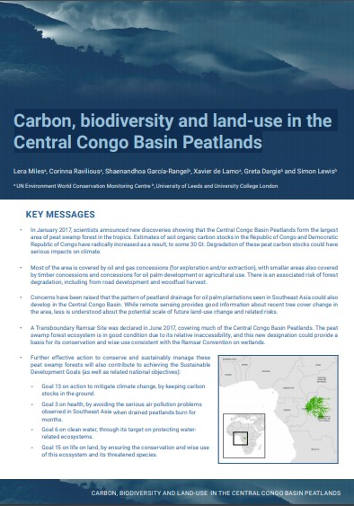Carbon, biodiversity and land-use in the Central Congo Basin Peatlands

Key messages:
• In January 2017, scientists announced new discoveries showing that the Central Congo Basin Peatlands form the largest area of peat swamp forest in the tropics. Estimates of soil organic carbon stocks in the Republic of Congo and Democratic Republic of Congo have radically increased as a result, to some 30 Gt. Degradation of these peat carbon stocks could have serious impacts on climate.
• Most of the area is covered by oil and gas concessions (for exploration and/or extraction), with smaller areas also covered by timber concessions and concessions for oil palm development or agricultural use. There is an associated risk of forest degradation, including from road development and woodfuel harvest.
• Concerns have been raised that the pattern of peatland drainage for oil palm plantations seen in Southeast Asia could also develop in the Central Congo Basin. While remote sensing provides good information about recent tree cover change in the area, less is understood about the potential scale of future land-use change and related risks.
• A Transboundary Ramsar Site was declared in June 2017, covering much of the Central Congo Basin Peatlands. The peat swamp forest ecosystem is in good condition due to its relative inaccessibility, and this new designation could provide a basis for its conservation and wise use consistent with the Ramsar Convention on wetlands.
Topic: carbon, biodiversity, peatlands, land-use
Publisher: UNEP-WCMC
PublicationYear: 2017
g








